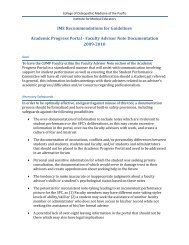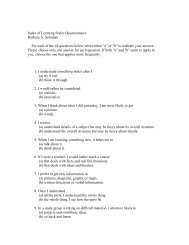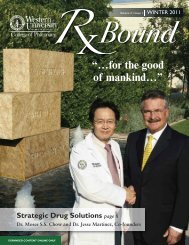Commencement! - Western University of Health Sciences
Commencement! - Western University of Health Sciences
Commencement! - Western University of Health Sciences
You also want an ePaper? Increase the reach of your titles
YUMPU automatically turns print PDFs into web optimized ePapers that Google loves.
• 21% ($190.2 billion) <strong>of</strong> annual medical spending in<br />
the U.S. is on obesity-related illness.<br />
• 23% <strong>of</strong> adolescents are diabetic or pre-diabetic.<br />
“If nothing else moves you about<br />
what I say, this is the (statistic)<br />
that should move you,” Crawford<br />
said <strong>of</strong> the adolescent<br />
diabetes/pre-diabetic figure. “This<br />
is unacceptable.”<br />
She did not point to a single<br />
cause for the surge in obesity<br />
over the past 40 years, but rather<br />
attributed it to a variety <strong>of</strong><br />
College <strong>of</strong> Pharmacy dean emeritus, Max Ray, PharmD<br />
factors, including poor access to<br />
fresh produce and food variety in urban communities;<br />
a lack <strong>of</strong> emphasis on physical activity, especially for<br />
children; the addition <strong>of</strong> calorie-laden sugar and<br />
carbohydrates to a broad range <strong>of</strong> food to make them<br />
more appealing; and an absence <strong>of</strong> meaningful<br />
nutrition education in communities and schools.<br />
“What we’ve done in this country is make it pretty<br />
darn easy to eat a lot <strong>of</strong> foods that makes us heavy,”<br />
she said.<br />
Crawford, who served as an adviser for the HBO series<br />
“The Weight <strong>of</strong> the Nation,” and is a member <strong>of</strong><br />
several weight- and obesity-related boards and<br />
committees, presented the recommendations from one<br />
<strong>of</strong> those groups – the Institute <strong>of</strong> Medicine’s<br />
Accelerating Progress in Obesity Prevention committee<br />
– for curbing the obesity epidemic. The<br />
recommendations, which take a whole-community<br />
approach to solving the problem, include:<br />
• Increasing places and opportunities for physical<br />
activity.<br />
only four hours <strong>of</strong> nutrition education per year,<br />
while older children and adolescents consume more<br />
than 7.5 hours <strong>of</strong> media each day. Nutrition<br />
information must be increased in schools and<br />
incorporated into the media<br />
children consume, Crawford said.<br />
• Making schools the focal point <strong>of</strong><br />
obesity prevention.<br />
Some small victories have been<br />
achieved in the battle against<br />
childhood obesity recently,<br />
Crawford said, including passage <strong>of</strong><br />
the <strong>Health</strong>y Hunger-Free Kids Act <strong>of</strong><br />
2012, which increases schools’<br />
federal reimbursement for lunches<br />
by 60 cents and gives the USDA authority for all foods<br />
sold at school. In California, passage <strong>of</strong> a law ending<br />
soda sales on school property also has curbed their<br />
consumption by young people.<br />
Consequently, school lunches are now, on average,<br />
healthier than lunches brought from home. Children<br />
receive up to half <strong>of</strong> their daily calories in a school<br />
setting, and with healthier choices available, “we’ve<br />
found that children are more likely to select healthy<br />
foods if they are <strong>of</strong>fered healthy foods,” she said.<br />
But much work clearly remains to be done, and<br />
Crawford – looking squarely into the eyes <strong>of</strong> the many<br />
health pr<strong>of</strong>essions students in the lecture hall – said<br />
care providers must be one <strong>of</strong> the main messengers<br />
about good nutrition and healthy lifestyles.<br />
“You, in a way, have the bully pulpit with your<br />
patients. They trust you. They believe you. It’s up to<br />
you, to adults – to all <strong>of</strong> us, really – to educate<br />
everyone. We can begin to make healthy choices the<br />
easy choice,” she said.<br />
• Reducing unhealthy food and beverage options, and<br />
making their healthy replacements affordable.<br />
• Transforming message environments about<br />
nutrition. Crawford noted that most schools <strong>of</strong>fer<br />
“We have to change the culture, and you all are the<br />
culture leaders. We can begin to start changing the<br />
environment in which our children live.”<br />
– Jeff Keating<br />
<strong>Western</strong>U View Summer 2013 23

















